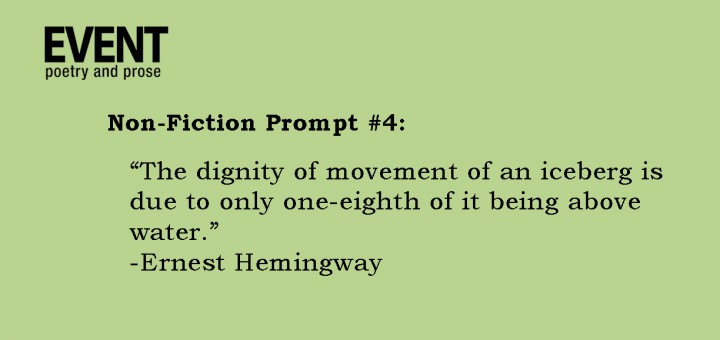Non-Fiction Prompt #4
This exercise is inspired partly by Ernest Hemingway’s minimalist writing style, and partly by an exercise from John Gardner’s craft book, The Art of Fiction.
In Death in the Afternoon, Hemingway wrote:
If a writer of prose knows enough of what he is writing about he may omit things that he knows and the reader, if the writer is writing truly enough, will have a feeling of those things as strongly as though the writer had stated them. The dignity of movement of an iceberg is due to only one-eighth of it being above water. A writer who omits things because he does not know them only makes hollow places in his writing.
Here’s a thought from Nicholson Baker’s The Anthologist:
Somebody told me a story about a dog who ate a sock. The vet couldn’t ‘shift it,’ so he removed the sock surgically and now the dog is doing well. And there were other stories, too. If you listen to them, the stories and fragments of stories you hear can sometimes slide right into your poem and twirl around in it. Then later you cut out the story and the poem has a mysterious feeling of charged emptiness, like the dog after the operation.
Baker’s quote describes poetry and Hemingway’s describes prose, but both suggest the same idea, that the writer knows more than what what we read in the final piece. The writer has a crucial decision to make: what to leave off the page. How do you create that feeling of “charged emptiness,” of emotions and mysteries latent under the story’s surface?
John Gardner’s exercise shows one approach, asking writers to describe a setting as seen by someone who has just committed a murder. There’s only one rule: don’t mention the murder. The reader should be able to intuit that something terrible has just occurred from the character’s mental state. Everything the narrator describes should be coloured by this experience.
Here’s our non-fiction version of the exercise:
Write a scene that depicts yourself after experiencing sadness or trauma. The trauma can be as large or small as you want, eg. failing an exam, ending a relationship, losing a pile of money at the casino. Don’t mention the trauma in the scene. Your scene might show your narrator eating a meal, speaking with a friend, going shopping, feeding birds at a pond, etc. Your narrator can be alone or with another person. The challenge here is to illustrate emotion indirectly, to “show don’t tell.” Let the character’s emotions pervade the narrator’s actions, thoughts and words.
—
Details on EVENT’s 2016 annual Non-Fiction Contest. Now accepting online submissions!














